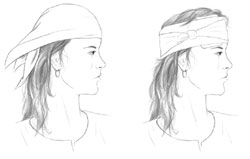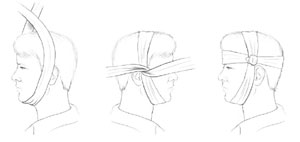Bandaging a deep wound requires more than simply sticking a Band-Aid over the cut and hoping for the best. Deep wounds require bandages that are administered after a wound is cleaned and treated at the hospital.
Bandaging Head Wounds
If a wound affects the scalp, the bandage should be made by tying a kerchief on the head and knotting it in the back. If a wound only affects the forehead, put a square of sterile gauze pad over the wound. Then wrap a sterile gauze bandage around the head, “sweatband” style. Circle the head at least three times to keep the dressing underneath in place. Cut and use adhesive tape to attach the ends, or tie them with a firm knot. You can also use a large piece of cloth, wrapping it several times around the head. Tie the ends in place above the eyes in the middle of the forehead. Ears and cheeks require a bandage that is more like an “old-fashioned toothache” style. These steps teach you how to apply such a bandage.
Wrapping Knee and Leg Wounds
To make a bandage that won’t come apart on the knee or leg, follow these steps: Follow these steps to apply a bandage to the leg using a spiral technique:


